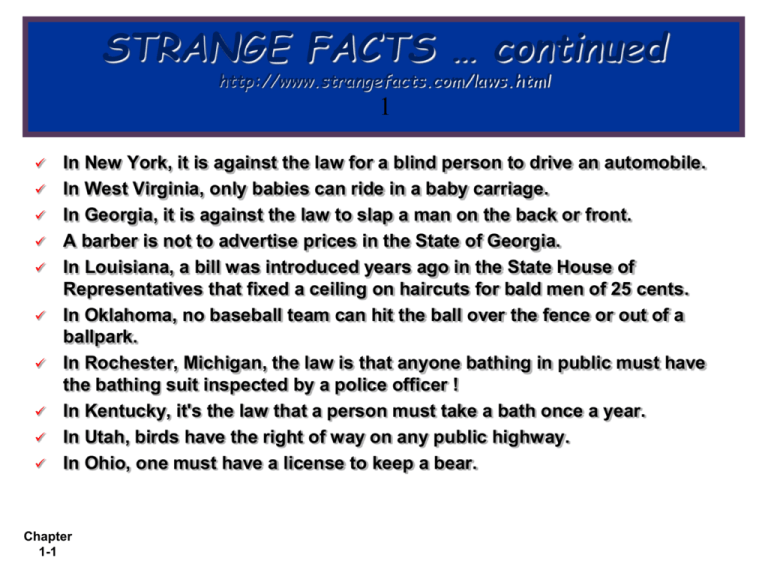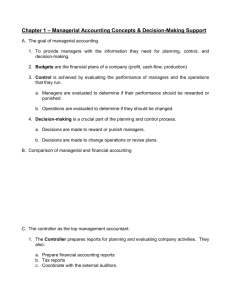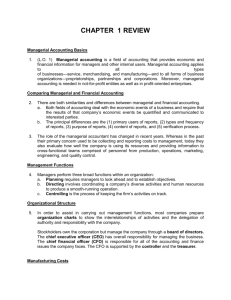
STRANGE FACTS … continued
http://www.strangefacts.com/laws.html
1
In New York, it is against the law for a blind person to drive an automobile.
In West Virginia, only babies can ride in a baby carriage.
In Georgia, it is against the law to slap a man on the back or front.
A barber is not to advertise prices in the State of Georgia.
In Louisiana, a bill was introduced years ago in the State House of
Representatives that fixed a ceiling on haircuts for bald men of 25 cents.
In Oklahoma, no baseball team can hit the ball over the fence or out of a
ballpark.
In Rochester, Michigan, the law is that anyone bathing in public must have
the bathing suit inspected by a police officer !
In Kentucky, it's the law that a person must take a bath once a year.
In Utah, birds have the right of way on any public highway.
In Ohio, one must have a license to keep a bear.
Chapter
1-1
CHAPTER 1
MANAGERIAL
ACCOUNTING
Managerial Accounting, Fifth Edition
Chapter
1-2
Managerial Accounting Basics
Definition of Managerial Accounting
A field of accounting that provides economic and
financial information for managers and other
internal users.
Also called Management Accounting.
Chapter
1-3
Managerial Accounting Basics
Distinguishing Features
Applies to all types of business Service, Merchandising, and Manufacturing.
Applies to all forms of business organizations –
Proprietorships, Partnerships, and Corporations.
Applies to not-for-profit as well as profit-oriented
companies.
Chapter
1-4
SO 1 Explain the distinguishing features of managerial accounting.
Managerial Accounting Basics
Distinguishing Features (Continued)
Responsible for strategic cost management – assisting in
evaluating how well resources are employed by the
company.
Allows for valuable input from a variety of departments
including production, marketing, ngineering, etc.
Aid in making critical strategic decisions.
Chapter
1-5
SO 1 Explain the distinguishing features of managerial accounting.
Comparing Managerial and Financial Accounting
Similarities
Both managerial and financial accounting deal with
economic events of a business –
Thus, interests overlap.
Both require that economic events be
quantified and communicated to
interested parties –
Determining unit cost is part of
managerial accounting,
Reporting cost of goods manufactured
is a part of financial accounting.
Chapter
1-6
SO 1 Explain the distinguishing features of managerial accounting.
Managerial Accounting Basics
Management Functions
Management’s activities and responsibilities can be
classified into the following three broad functions:
Planning,
Chapter
1-7
Directing, and
Controlling.
SO 2 Identify the 3 broad functions of management.
Organizational Structure
Within a company, organization charts show:
The interrelationships of activities and
The delegation of authority and responsibility.
Chapter
1-8
Illustration 1-2
Good Ethics – Good Business
Business Ethics:
All employees are expected to act ethically.
An increasing number of organizations have codes
of business ethics.
Despite organizational efforts:
Business scandals have caused massive
investment losses and employee layoffs.
Corporate fraud has increased 13% in last 5
years.
Employee fraud – 60% of all fraud.
Intentional misstatement of financial reports .
(Financial reporting fraud is most costly .)
Chapter
1-9
Good Ethics – Good Business
Creating Proper Incentives:
Companies like Motorola, IBM, and Nike
expend substantial resources to monitor and
evaluate the actions of employees & managers.
Monitoring can have the negative result of
producing incentives for unethical actions.
Employees may feel that they must succeed no
matter what.
Ineffective and unrealistic controls may also
result in declining product quality.
Chapter
1-10
Good Ethics – Good Business
Code of Ethical Standards
Sarbanes-Oxley Act of 2002
Clarifies management’s responsibilities.
Certifications by CEO and CFO fairness of financial statements and adequacy of
internal control.
Selection criteria for Board of Directors and Audit
Committee.
Substantially increased penalties for misconduct.
IMA Statement of Ethical Professional Practices.
Chapter
1-11
Managerial Cost Concepts
Manufacturing Costs
Manufacturing consists of activities and processes
to convert raw materials into finished goods.
In contrast, a merchandising firm sells goods in the
form in which they were purchased.
Manufacturing costs are typically classified as:
Direct Materials
Direct Labor
Manufacturing Overhead
Illustration 1-3
Chapter
1-12
SO 3 – Define the three classes of manufacturing costs.
Manufacturing Costs
Materials
Raw Materials:
Basic materials and parts used
in manufacturing process.
Direct Materials :
Raw materials that can be
physically and directly associated
with the finished productduring the
manufacturing process.
Chapter
1-13
SO 3 Define the three classes of manufacturing costs.
Manufacturing Costs
Materials
Indirect Materials:
Raw materials that cannot be easily associated
with the finished product.
Not physically part of the finished product or
they are an insignificant part of finished
product in terms of cost.
Considered part of manufacturing overhead.
Chapter
1-14
SO 3 Define the three classes of manufacturing costs.
Manufacturing Costs
Labor
Direct Labor:
Work of factory employees
that can be physically and
directly associated with
converting raw materials
into finished goods.
Indirect Labor:
Work of factory employees that has no
physical association with the finished product
or for which it is impractical to trace costs to
the goods produced.
Chapter
1-15
SO 3 Define the three classes of manufacturing costs.
Manufacturing Costs
Manufacturing Overhead
Costs that are indirectly associated with
manufacturing the finished product.
Includes all manufacturing costs except direct
materials and direct labor.
Allocation of overhead to products can present
problems.
Also called factory overhead, indirect
manufacturing costs, or burden.
Chapter
1-16
SO 3 Define the three classes of manufacturing costs.
BE1-4 page 35
Chapter
1-17
Determine whether each of the following costs
should be classified as direct materials (DM),
Direct Labor (DL), or Manufacturing Overhead
(MO)
Frames and tires used in manufacturing bicycles
Wages paid to production workers
Insurance on factory equipment and machinery
Depreciation on factory equipment
Answers to BE1-4
Chapter
1-18
Frames and tires would be Direct Materials
Wages to Production workers would be Direct
Labor
Insurance on factory Equipment would be
Manufacturing Overhead
Depreciation on factory Equipment would be
Manufacturing Overhead
BE 1-5 page 35
Indicate whether each of the following costs of an
automobile manufacturer would be classified as
direct materials, direct labor or manufacturing
overhead…
•
•
•
•
•
•
•
•
Windshield
Engine
Wages of assembly line worker
depreciation of factory machinery
factory machinery overhead
tires
steering wheel
salary of painting supervisor
Chapter
1-19
BE 1-5 page 35
Chapter
1-20
Windshield DM
Engine DM
Wages of assembly line worker DL
depreciation of factory machinery MO
factory machinery overhead MO
tires DM
steering wheel DM
salary of painting supervisor IL or MO
Product Versus Period Costs
Product Costs
Components: Direct material cost, direct
labor cost, and manufacturing overhead.
Costs that are a necessary and integral
part of producing the product.
Recorded as inventory when incurred, thus
may be called inventoriable costs.
Not an expense until the finished goods
inventory is sold, then cost of goods sold.
Chapter
1-21
SO 4 Distinguish between product and period costs.
Product Versus Period Costs
Period Costs
Matched with revenue of a specific
time period and charged to expense as
incurred.
Non-manufacturing costs.
Deducted from revenues in period
incurred to determine net income.
Includes all selling and administrative
expenses.
Chapter
1-22
SO 4 Distinguish between product and period costs.
Product Versus Period Costs
Illustration 1-4
Chapter
1-23
SO 4 Distinguish between product costs and period costs.
BE 1-6 PAGE 36
•
•
•
•
•
•
Chapter
1-24
Identify whether each of the following costs
would be classified as product cost or period
costs.
Manufacturing Overhead
Selling Expenses
Administrative Expenses
Advertising Expenses
Direct labor
Direct materials
BE 1-6 PAGE 36
•
•
•
•
•
•
Chapter
1-25
Identify whether each of the following costs
would be classified as product cost or period
costs.
Manufacturing Overhead - Product Cost
Selling Expenses – Period Cost
Administrative Expenses – Period Cost
Advertising Expenses – Period Cost
Direct labor – Product Cost
Direct materials – Products Cost
Manufacturing Costs in Financial Statements
Income Statement
The income statement for a manufacturer is
similar to that of a merchandiser except
for the cost of goods sold section.
Chapter
1-26
SO 5 Explain the difference between a
merchandising and a manufacturing income statement.
Manufacturing Costs in Financial Statements
Cost of Goods Sold Section of the Income Statement
Illustration 1-6
Chapter
1-27
SO 5 Explain the difference between a merchandising
and a manufacturing income statement.
Manufacturing Costs in Financial Statements
Determining the Cost of Goods Manufactured
Illustration 1-7
Work in Process – partially completed units of product.
Total Manufacturing Costs – sum of direct material costs,
direct labor costs, and manufacturing overhead; all
incurred in the current period.
Chapter
1-28
SO 6 Indicate how cost of goods manufactured is determined.
Manufacturing Costs in Financial Statements
Illustration 1-8
Chapter
1-29
SO 6 Indicate how cost of goods manufactured is determined.
Manufacturing Costs in Financial Statements
Review Question
For the year, Red Company has cost of goods
manufactured of $600,000, beginning balance of
finished goods inventory of $200,000, and ending
balance of finished goods inventory of $250,000.
The cost of goods sold is:
a.
$450,000.
b. $500,000.
c.
$550,000.
d. $600,000.
Chapter
1-30
Manufacturing Costs in Financial Statements
Review Question
For the year, Red Company has cost of goods
manufactured of $600,000, beginning balance of
finished goods inventory of $200,000, and ending
balance of finished goods inventory of $250,000.
The cost of goods sold is:
a.
$450,000.
b. $500,000.
c.
$550,000.
d. $600,000.
Chapter
1-31
Beginning Inventory
$200,000
Cost of Goods Manufactured 600,000
$800,000
Minus Ended Finished Goods 250,000
Cost of Goods Sold
$550,000
SO 5 Explain the difference between a merchandising
and a manufacturing income statement.
Manufacturing Costs in Financial Statements
Balance Sheet - Inventories
Merchandising Company
Manufacturing Company
One category of inventory:
Merchandise Inventory
May have three inventories:
Raw Materials
Work in Process
Finished Goods
Chapter
1-32
SO 7 Explain the difference between a merchandising and a
manufacturing balance sheet.
Manufacturing Costs in Financial Statements
Balance Sheet - Inventories
Illustration 1-10
Chapter
1-33
SO 7 Explain the difference between a merchandising and a
manufacturing balance sheet
Managerial Accounting Today
Service Industry Trends
U.S. economy, in general, has shifted toward an
emphasis on providing services rather than goods.
Over 50% of U.S. workers are now employed by
service companies.
Trend is expected to continue in the future.
Most of the techniques learned for manufacturing
firms are applicable to service companies.
Chapter
1-34
SO 8 Identify trends in management accounting.
Managerial Accounting Today
Managerial Accounting Practices
Value Chain
Refers to all activities associated with providing a product or
service.
For a manufacturing firm these include the following:
Illustration 1-13
Chapter
1-35
SO 8 Identify trends in management accounting.
Managerial Accounting Today
Managerial Accounting Practices
Technological Change
Enterprise Resource Planning (ERP) – software
programs designed to manage all major business
processes.
Computer-Integrated Manufacturing (CIM) –
manufacturing products with increased automation.
Just-In-Time (JIT) Inventory Methods
Inventory system in which goods are manufactured
or purchased just in time for sale.
Chapter
1-36
SO 8 Identify trends in management accounting.
Managerial Accounting Today
Managerial Accounting Practices
Quality
Increased emphasis on product quality because
goods are produced only as needed.
Total Quality Management (TQM)
- a philosophy of zero defects.
Activity-Based-Costing (ABC)
Allocates overhead based on use of activities.
Results in more accurate product costing and
scrutiny of all activities in the value chain.
Chapter
1-37
SO 8 Identify trends in management accounting.
Managerial Accounting Today
Managerial Accounting Practices
Theory of Constraints
Constraints (“bottlenecks” ) limit the company’s
potential profitability.
A specific approach to identify and manage these
constraints in order to achieve company goals.
Balanced Scorecard
Evaluates operations in an integrated fashion.
Uses both financial and non-financial measures.
Chapter
1-38
Links performance measures to overall company
objectives.
SO 8 Identify trends in management accounting.
Chapter Review – Do it! 1-2
A Music Company has these costs: Classify these
cost as period or product and indicate if the cost
are part of direct materials (DM), direct labor
(DL) or manufacturing overhead (MO).
______
______
______
______
______
______
______
______
Chapter
______
1-39
a. Advertising
b. Blank CDs
c. Depreciation on CD image burner
d. Salary of Factory manager
e. Factory supplies used
f. Paper inserts for CD cases
g. CD plastic cases
h. Salaries of factory maintenance employees
i. Salaries of employee who burn music onto CDs
Any
Questions?
Dcummings@kaplan.edu
Chapter
1-40
Copyright
Copyright © 2010 John Wiley & Sons, Inc. All rights reserved.
Reproduction or translation of this work beyond that permitted
in Section 117 of the 1976 United States Copyright Act without
the express written permission of the copyright owner is
unlawful. Request for further information should be addressed
to the Permissions Department, John Wiley & Sons, Inc. The
purchaser may make back-up copies for his/her own use only
and not for distribution or resale. The Publisher assumes no
responsibility for errors, omissions, or damages, caused by the
use of these programs or from the use of the information
contained herein.
Chapter
1-41







